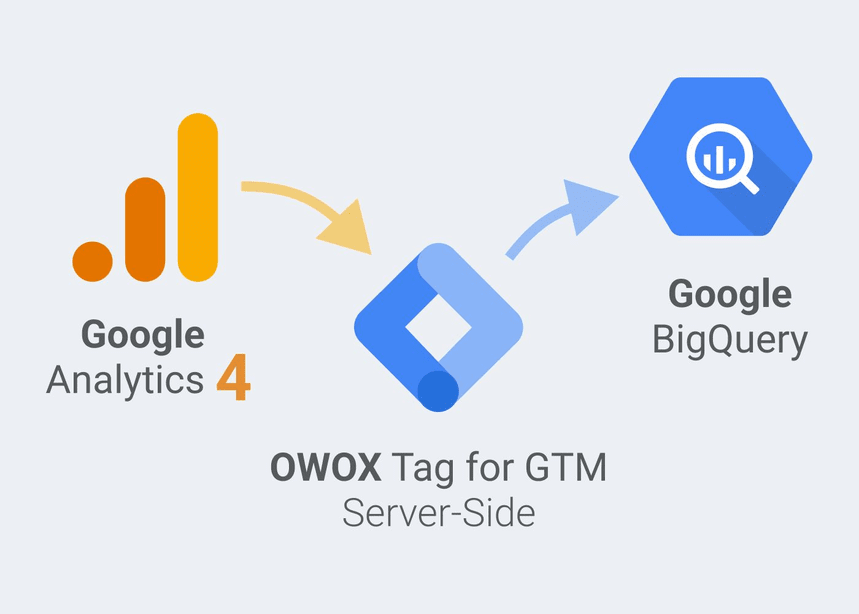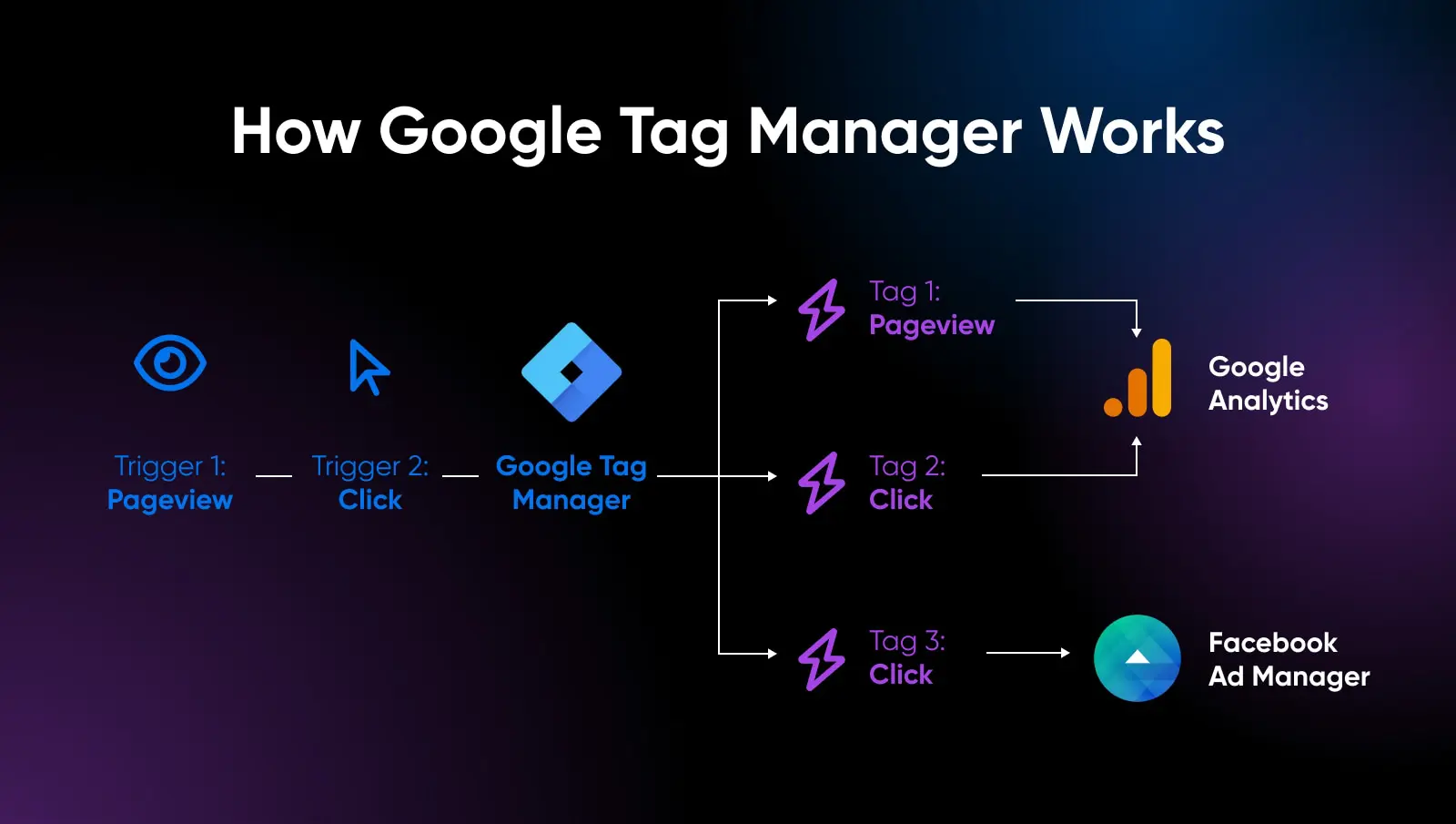Google Tag Manager agency setup and management tutorial with certified Google Tag Manager consultants. Optimise your data collection and website analytics.
Table of Contents
ToggleGoogle Tag Manager (GTM) is the most likely to be the one software tool the use of which your team could use to gather information and make savvy marketing insights.
The advantages of GTM and how they can be applied correctly can be confusing to understand; that is why we created this guide as the point of reference.
By the time you finish reading this post, you will be able to create your own account and use it to get the most out of it (or upskill with the Google Tag Manager course).
Tag mapping – configure tags, triggers & variables
 Snippets of JavaScript code with data and information, which are added to a webpage, are called tags. They assist you in tracking the activity of visitors to your site/app in order to optimise it with reference to their conduct.
Snippets of JavaScript code with data and information, which are added to a webpage, are called tags. They assist you in tracking the activity of visitors to your site/app in order to optimise it with reference to their conduct.
The majority of websites require a few tags so that they can monitor various behavioural patterns, as well as the user’s tracks, such as form hits or page clicks. The more tags that a website contains, the harder it may be to control.
GTM does not hold any information and will not provide reports, but rather collects the information. This is its largest variance with Google Analytics, which enables you to read the analytics data and study reports.
In other words, it is one of those handy tools that lets you do something you would not otherwise do. (via our Google Tag Manager course)
That is why there is Google Tag Manager.
GTM is not the sole tool in tag management; however, it is the most approachable one. It is meant to integrate perfectly with Google Analytics, and that is the reason we will concentrate on it. There are others, some of which are
Marketers can now access the customer information they require without necessarily having to go through a developer all the time as an intermediary. Here’s how:
Stay organised
A tag manager will not be available, without which a developer will have to do it manually on a site-by-site basis and apply the rules of each. In place, they will then have to manually observe the activities, troubleshoot problems, get rid of the expired code when an addition is made, manage conflicts, etc.
This is time-wasting and expensive. It helps to simplify the whole process of tag management.
 With GTM, it is possible to establish individual tags on all platforms on which you want to derive information concerning some events (like the purchase events on Google Ads).
With GTM, it is possible to establish individual tags on all platforms on which you want to derive information concerning some events (like the purchase events on Google Ads).
A ticket code component is a ticketing code content block (underemy)
Tag managers reduce how much hard-coded code appears throughout your site and enable the setting of all code snippets in a single location to keep all the tracking data orderly and tidy. And it is also easy to use and does not require a developer to come and make a code implementation or change.
Consider tag management the way it is, the manager of your content marketing project. It is possible to organise a publishing schedule, assignments, tasks, and documents into one place, and even automate the activities, but without having a person to track the work will most likely fail.
Although you do not require the services of a developer to supervise a tag manager, you do require the services of people to observe this and implement more advanced procedures such as complicated tracking implementations, custom JavaScript variables or dataLayer set-ups. Nevertheless, do not leave IT out of the picture. Non-trivial tagging activities, perhaps, will still be required to be done through a rule-based, graphical interface.
Costs of technology should be lateralised.
There will always be bugs and barriers, but GTM does make tracking management easier; it does not, however, mean that proper implementation is not required. There is still a need to be familiar with the dataLayer structure, triggers and tag firing logic when trying to debug it.
A quicker launch will free up time in your overall team so that the resources are utilised to the best. GTM is also not at all expensive, and therefore your department does not have to set aside any of its budget to use another marketing cloud.
You are wrong, Google Tag Manager 360 (enterprise user) is paid.
Still, mistakes do take place and can happen. The following best practices can be used to ensure that costs remain low and that there is no need to go back and correct something a user did wrong:
- Be specific in your goals and follow what actually needs to be measured instead of spreading a big net and getting irrelevant data that you neither use nor analyse;
- Do not make a burden out of tags by adding a lot of them to each page. You will make the page load slow to a crawl.
- Remember to delete or deactivate tags that are not in use, particularly at the end of a test, and in the case that one has chosen not to go any further than trial.
- Custom HTML tags must be tested and checked properly with the help of Preview Mode.
- Make sure to install alerts on analytics and always QA new implementations so that you get them before they are covered up.
- You should have publishing rights on people with system knowledge, because providing additional account privileges to the unqualified staff members may endanger the activity.
Get the maximum out of your own in analytics-
 There is no reporting and analytics with Google Tag Manager. Instead, it assists in installing tracking scripts (tags) that can transmit useful information, which it captures to Google Analytics 4 to be analysed.
There is no reporting and analytics with Google Tag Manager. Instead, it assists in installing tracking scripts (tags) that can transmit useful information, which it captures to Google Analytics 4 to be analysed.
GA4 provides crucial data, including real-time pageviews, referral traffic, and the most successful pages, and GTM allows capturing even more information, i.e., clicks on buttons, forms, etc., and tracing the user path, hence providing insight into user behaviour.
Your entry-level analytics tool will be able to locate things such as:-
- Real-time pageviews
- Where visitors to the site hail, where the architecture of the position of the visitor is located
- Traffic sources
- America blogs / America good page / odyssey online / America
Tags, however, allow you to dig deeper and find out things such as:
- The way that the visitors will navigate your site-
- Which are the most conversant pages out of the lot of pages
- The visitors to your website are susceptible to abandoning your site
How to set up Google Tag Manager for any agency and company website
This is what you have to do so that your Tag Manager account is implemented:
1. There is a starting point, and it is your goals
Identify your objectives for tracking to identify the type of tags that you need to produce.
You can come up with tags
- Google Adverts: Retargeting (tracking, Conversion tracking).
- Observing the answers on the form that has been filled in or clicking on the button.
- Third-party integrations that can be connected to retrieve information on-site, such as Hotjar, Oktopost or Pinterest.
It is always advisable to come up with a plan of tracking that will then take you to the Google Tag Manager to create an account.
2. Set up an account
You will be able to get the activation underway once you log in to the system using your Google account, and then you need to create an Account:
You will open a Google Tag Manager account under your Google email, and this is why you should select an account GTM administrator or owner first. Subsequently, there is a possibility to share permissions with the other individuals in the team who require access to it.
The second step will be to get your container ready.
Here, you would be required to give your account a name. It is best practice to name it after your business to have a simple tag management.
Pick out the kind of platform you would like your site or app to appear on and go to Create. All your tags will be within a container, and you have to name them based on the site or the address.
One of the divisions of this Flag has been reported to consist of two divisions. This might be the internet, an iOS or Android mobile application, the use of AMP or the use of a server:
The next thing you have to do is to place the container snippet in your site. This is a bit of JavaScript that must reside on all pages such that the tags are able to fully track activity.
This Flag has two parts to it
- The latter would have to be at the <head> of your website;
- The latter will have to be pasted in the <body> area.
The three principal labels you are going to use in the sidebar of your GTM dashboard are tags, triggers, and variables:
- Tags are tracking codes that collect data from a website or app.
- Triggers set conditions that tell a tag when to fire;
- Variables define when triggers should tell tags to fire.
3. Install the Google Analytics 4 tag of Google Tag Manager Agency and tutorial
You need to make a GA4 Configuration tag in the event that you have Google Analytics 4. Remember, though, that doing this via GTM would also require you to remove any Google Analytics tracking code you might have already put on your website; otherwise, you will end up with duplicate data.
The first thing that you would like to do is click the Add a new tag in your dashboard, e.g., GA Pageviews:
The other alternative is to develop your tag. By clicking on the upper box, the list of the 50+ variations of the tags will appear:
This will do the task of opening Google Analytics: GA4 Configuration, which can be chosen when it is clicked on.
On the drop-down box that appears, Page Views is to be clicked:
4. Or you can create a fake name for your own device
There are two choices you can make in setting up your variable. The first step would be to first enable override setting of this tag, and afterwards, the Tag configuration would always be set to your GA4 Measurement ID of Google Tag Manager Agency:
Variables in GTM come in two forms, those are: This may require a bit of extra initial setu,p but will also make web analytics less painful in the end since it has your GA4 Measurement ID hardcoded so all you have to do is create a new tag and you will not have to copy/paste it every time.
There Should Be a Paste Tracking ID In The Box. Paste Tracking ID, then hit Save:
- On Paste Tracking ID, hit save.
- User-defined variables.
Baked in variables are also automatically defined by the GTM based on the things that it finds in the snippet of code. They propose a number of common types of variables that expedite the creation of basic tags.
When you see the Configure button, it is time to configure all of the variables you will require in the future. This thou mayst have again, and add more thereto:
The user-defined variables are user-specific, depending on values established by the user. You can do that by defining a constant variable and you? scientifically-shaped brain with an injection needle and doughnuts on the background image as the background of a scientific monument 39765275
The same can be achieved by pressing New in the section of User-Defined Variables. Then, navigate to variable types and scroll to the bottom of where you will find something like Google Analytics Settings:
On Paste Tracking ID, click on save to:
These days, when you set your Google Analytics tag, you will not need to tick the Mark overrides settings in this tag. Rather than selecting your new variable after opening the drop-down, what you simply need to do is choose the new variable:
5. Configure your trigger
The last step that you need to go through when implementing your first tag is selecting a trigger that will cause the tag to be fired:
Just to do that, simply choose Houdini and choose Triggering box, and choose All Pages:
And round and round about, turn on it. When you feel the time to track, press Submit on whatever you feel you have altered in the workspace. There are two new ones to be usually involved, i.e. one new variable and one new tag:
6. Set up cross-domain tracking
In case your customer journey causes users to end up in other domains, then cross-domain tracking enables you to make sure that your tracking code also counts your users as one, and does not spuriously inflate your data so as to count each user multiple times (i.e., once per domain they visit).
This is not required when setting up subdomains; only in case you have two domains that do not at all work together.
- Go to Google Analytics > Admin > Data Streams.
- Click your GA4 Web Data Stream.
- Under Configure Tag Settings, click Show More Settings.
- Click Configure Domains and enter your domains (e.g., example.com, examplepayments.com).
- Click Save.
Note: With cross-domain tracking, you need not specify the feature of configuring the option of setting exceptions in GTM to override the settings; it is automatic in case of GA4.
7. Understand the data layer
The data layer is a JavaScript piece of code that saves the information of your site prior to it being sent to GTM. It acts as a guard between your site markup (HTML), which can never remain constant, and your tags, triggers and variables.
The presence of a data layer will facilitate the process of data collection in your organisation. Nevertheless, you do not have to worry about most tags, as the data layer is called by the original GTM code fragment you pasted to your site.
But depending on whether you wish to gather customised data, such as product data or transaction data in the case of eCommerce tracking, you would require a custom data layer to be implemented.
To accomplish this, you should come up with a data layer variable. This will enable GTM to consume more values from your website and send the same to your deployed tags.
Your development staff will be required to help in formatting and adding data layer code snippets to every page that you would like to have more information tracked over. These will have to be done on a page-by-page basis, and the script will appear in the form of this one in the developer tools of Google.
Data layer keys in this case consist of two data layer keys: page category and visitor type. You may only have a single key, and you may also have multiple keys, depending on what you need to monitor.
However, as soon as your developer has pasted this code on every respective page, a new data layer variable is supposed to be established that will belong to every key. Go to the variable tab right right-click, select, and create the variable as a new user-defined Variable. The variables of the Data Layer are selected by clicking on it and selecting the option of list option:
On the Data Layer Variable Name field, you must type the name of the key in the same manner as written in the code. In that case, based on the above example, you would create two variables in the data layer. One would be called pageCategory, and the other would be visitorType:
8. Go to the front end, log in and then click on Admin and Manage user
You are able to add or take away users or groups of users in your GTM according to who requires access. One accesses the Admin and user Management through logging in to see it.
You will have a bird’s-eye view of all users who are using it now, as well as the type of access they have. Either you are in a position to get new students by issuing a visa or not.
- This is capable of creating and destroying containers and establishing user rights.
It is able to see the information in default accounts as well as browse through some containers.
At the level of containers, you can also set the permissions of the users so that the User has no permissions to some containers, Read-only permission, write permission, approve edit permission, and publish edit.
Best practice: Do not allow additional user access to tags so accidental deployments of tags do not take place. Add each one of your team members and set the individual permissions according to the quality of change, and implement new tags.
Using Google Tag Manager Agency to track behaviour effectively
The following are some tips that you can apply in the use of GTM.
Make sure that the simple code of GTM is on every page
You also do not want to set up a more detailed tracking campaign, only to find out after the fact that your GTM base code is missing on most of your key pages. This is the reason why it is important that the code be successfully inserted into the HTML of your site.
There are several ways that you can do this, but the simplest is to view the page source of your website.
Look at the source code – Right-click on the page on which the source code is to be seen. gtm.js, to be sure that you do get the plain text, it is possible to use the search page (CTRL+F/CMND+F command):
One can also use Google Tag Assistant or some DevTools (Chrome has a tab called “Network” ) to check GTM activities without trouble.
You also may click the Preview button on the top right of the GTM dashboard, and enter your web page address to check whether the proper container has been implemented on your site:
Each time you create a new container, make sure to do the verification that the code was applied correctly.
To do better, place the GTM base code in <head> and the noscript version of the iframe in <body>.
Track events
The use of Google Tag Manager together with Google Analytics is excellent when monitoring the events that take place on your site.
This may be a result of the following events:
- Form submissions
- Button clicks
- Sign-ups
- Scrolls
- Video views
To do so, you will have to create another Google Analytics: GA4 tag, but this time the Track Type should be Event.
There are various event tracking tags that you can create to get information on the behaviour of your customers, but you should not get swamped with information that may not make a difference in your bottom line.
Best Practice: Use the names of the events that Google insists on in GA4 to specify that the names are acceptable in automatic reports. Take a look at the web page that explains how to name the GA4 events
Debug your tags
Make sure to monitor your tags so you will be aware that they are functioning and that your data is not false. To do this, preview and debug mode should be used.
As simple as installing your base code, you just have to open your Preview and ensure the Include debug signal in the URL is not unticked. In the Click on Connect, enter the name of the website. They will establish a preview window that will have an icon at the bottom right:
You can now go back to Tag Assistant and be sure that everything is interconnected:
This can be used to go through each of the options and find whether anything is broken or not:
Best Practice: The tracking should be made accurate, and therefore, tags should be periodically checked by an auditor after alterations in the site.
Create constant variables
It is time to know how to make a lasting variable for your Google Analytics Tracking ID. You would already have other pixels on your website, though, when you are doing retargeting utilising electronic advertising.
You can also have the distinction of the constant variables of those pixels so that you are not required to come up with the relevant pixel every time, but rather select one through a drop-down.
A user-defined variable has to be created in the Variables. In Constant, you are able to do it with the Tracking ID being possible (eg. Take a note of the GA4 Measurement ID ( or Meta Pixel ID in case of Facebook ) and copy the values and save them.
As you name your variables, ensure it is easy to tell the pixel that has to be added to the tags.
Best Practice: name your variables in a manner that makes it easy to refer to them, i.e. call them Measurement ID GA4 or Meta Pixel ID.
Install extensions
Google Tag Manager even has two Google Chrome extensions, which may simplify your life:
- Google Tag Assistant is a particular extension that assists one in scanning tags across their site as one browses a page.
- Tag Manager Injector is a very useful extension that should be applied when debugging and testing any newly launched tags.
- DataLayer Inspector + can train your team on what is going to the data layer, and whether there are issues or not.
Best Practice: This should be in conjunction with GA DebugView to have a full-blown debugging capability.
Create a tag naming process for Google Tag Manager Agency
Engage your people together in coming up with a system or a name that you can give to all your tags so that all are aware of what they are all getting hold of in regards to the tags. Write down the way these names appeared so that the team can be aware of every tag’s functionality in a second.
Get together with your team to devise a process or a format to name all your tags in such a way that everyone in the team knows what each of the tags is monitoring. Write an explanation of how those names are formed so that the team has an idea at a single look as to what each tag does.
As a case in point, one of the tags may be tag type, followed by what it is tracking and then the specified trigger. Make up acronyms or shortenings that your team will use in order to be organised.
Best Practice: Make sure that you have a shared GTM documentation file that can give a summary of tag names, triggers and variables.
The disadvantages of Google Tag Manager Agency
The dark aspects of the GTM. The enemies of the GTM
Using Google Tag Manager is not without its technical restrictions, the majority of which involve quotas and account quotas.
Most of the small and medium businesses are not going to worry about these. Some of these limits are likely to pose serious constraints on big organisations and organisations.
The following are some of the disadvantages of Google Tag Manager:
Container (size) limits
All Google Tag Manager accounts have a limit of 500 containers. All the containers should be less than 200KB.
The containers with more tags, triggers and variables fixated on them, the higher their file size. These limits impede how many lines of code can be put into a site using Tag Manager to some extent.
Accounts and work limits
One Google account is the maximum number of Tag Manager accounts that can be managed. In the majority of cases, this is sufficient.
Under the free form of Google Tag Manager, you are allowed to have up to three workspaces. The paid one, Google Tag Manager 360, comes without any workspace limit.
Control of the rest of the world allowance
Tag Manager stipulates a range of additional restrictions by file size, code length, and the number of API requests as well.
- Max recipe (readymade containers) file size: 10MB.
- Max length of Constant Variable: 1024 characters.
- Max symbols/characters in a custom HTML tag: 102,400.
- Max API requests: 10,000 per project, per day. Max 0.25 queries per second.




